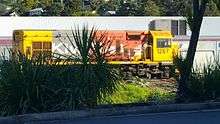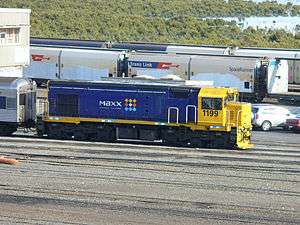New Zealand DB class locomotive
|
DBR 1199 at Westfield | |||||||||||||||||||||||||||
| |||||||||||||||||||||||||||
| |||||||||||||||||||||||||||
| |||||||||||||||||||||||||||
| |||||||||||||||||||||||||||
The New Zealand DB class and DBR class locomotive is a type of diesel-electric locomotive built for service on New Zealand's rail network. They were built by General Motors Diesel (GMD) of Canada as a narrow-gauge version of the EMD G8 model, with seventeen locomotives constructed. Ten of these were later rebuilt into the DBR class, of which only two are still in service today.
Introduction
The DB class was introduced to the rail network in 1965-66 as a result of a requirement for a modern locomotive that could operate on the North Island lines that the DA class was excluded from due to their weight and axle load. While these were mainly branch lines, it also applied to the East Coast Main Trunk line, particularly the section beyond Paeroa through the Karangahake and Athenree gorges, until the opening of the Kaimai Tunnel in 1978. The class was virtually indistinguishable externally from the DA class, being of the same basic design and dimensions, and wearing the same livery. They were some 13 tonnes lighter with a V8 prime as opposed to a V12, though they shared the same A1A-A1A wheel configuration and traction motors for commonality with the DA fleet.
Rebuild to DBR

In the late 1970s the decision was undertaken to rebuild the DB class along similar lines to that being undertaken for the DA class into the DC class. However, as the rebuild was not as extensive and did not involve conversion into another GMD model the rebuilt DB units were designated as DBR (R = rebuild). The work was undertaken by Clyde Engineering in Australia and involved the lowering of the short hood to improve visibility for the driver, new cabs and the installation of a new EMD 8-645 engine. Ten units were rebuilt between 1980 and 1982.
In service
The DB class was employed primarily freight duties, though they did also see occasional service hauling passenger trains. As lines and bridges were upgraded, and in the case of the ECMT the Kaimai Tunnel opening, the weight advantage the locomotives had over other classes used in the North Island became less of a factor and the locomotives were operated as part of a general pool. The lightweight nature of the locomotives was called upon again however to operate some South Island lines following the withdrawal of the DI and DJ classes. The last DBR returned north from the South Island in 2008.
Current
The remaining locomotives are all employed in the upper North Island. Two units were leased to Auckland Transport for suburban passenger services until 2014, with the remaining locomotives primarily employed in freight operations.
Auckland Transport
From 2006 to 2014 two locomotives were leased to the Auckland Regional Transport Authority and then its successor, Auckland Transport, with the services operated under contract by Transdev. The two locomotives, DBRs 1199 and 1254, are operated in a top and tail configuration with the five car SX carriage set, and wear the full MAXX Blue livery. A third unit, DBR 1226, is also painted in MAXX Blue but without the MAXX logo. DBR 1226 is usually used for freight services or work trains by KiwiRail, but was used as back up for DBR 1199 or DBR 1254 as it has the necessary modifications to work with the suburban carriages. The leases expired in 2014 and the locomotives returned to freight service.[1]
Wellington Bankers
For many years two DBR class locomotives formed the basis of a banker set out of Wellington, primarily assisting trains between Wellington and Paekakariki but also performing multiple other jobs including the Hutt Workshops shunt, work trains around the region and any unusual movements. DBRs 1199 and 1200 were the initial pair, becoming known as the "Bobsy Twins" (sp), likely a reference to the Bobbsey Twins due mainly to their consecutive numbers (a rarity under the TMS numbering system). In the early 2000s DBR 1199 suffered a failure and was withdrawn from service and laid up, replaced on the banker set by DBR 1267. DBR 1199 was later sent to Hillside for repair and use on the Auckland SX set commuter trains, by which time the pairing of DBRs 1200 and 1267 had become known simply as "The Twins". Following prolonged electrical trouble, in July 2013 DBR 1200 was taken out of service, and was replaced with other locomotives that were available. DBR 1267 was later transferred to Auckland to replace DBR 1282,[2] with the Wellington banking role taken over by other locomotives.
Numbering
The class was initially numbered DB 1000 to DB 1016, this being in common with NZR practice of the time to number locomotive classes with reference to the power output. Upon the introduction of the computerised Traffic Management System the class was renumbered and the designation capitalised. The class received new four digit numbers beginning with 1, in which the last number is a check digit for the whole number. Under the new system DB 1001 retained its number, becoming DB 1001, with DB 1000 becoming DB 1018. The rest of class was renumbered in sequence, with DB 1016 becoming DB 1180. The units being rebuilt to DBR received a new TMS number in the 12XX range when they entered the rebuilding cycle. The exception to this was the first unit rebuilt, DB 1076, which retained its original designation for a number of years before being redesignated DBR and renumbered 1199.
Livery
The locomotives were delivered in the same overall deep red livery as the DA class, with the same white stripes along the sides and 'wings' on the ends. With the introduction of TMS the locomotives road numbers were applied in large white numbers to the long hoods. This livery was worn by many of the unrebuilt DBs until their retirement, while the DBRs were returned to service in the International Orange or "Fruit Salad" scheme (red and grey with yellow safety ends) being applied to most classes at the time. DBs 1082 and 1099 also received this livery in the 1980s.[3]
DBR 1295 was repainted into the Toll Rail "Corn Cob" scheme (yellow and green), and the three units used on Auckland services have received the MAXX Blue livery (deep blue and yellow). More recently DBR 1267 has received the KiwiRail grey, red and yellow scheme.
Withdrawal

The remaining DB locomotives were withdrawn in the 1980s. DB 1024 was withdrawn in 1982 and DB 1145 in 1986, with the remainder out of service by the end of 1989 as part of the general draw-down on the locomotive fleet that took place at this time. All of these units were scrapped. Three of the DBRs – 1199, 1239 and 1241 – were withdrawn in 2002 as surplus to existing operational requirements. 1199 was returned to service a year later, but 1239 and 1241 served as parts sources for the remaining units. They were scrapped at Hutt Workshops at some stage between 2003 and 2008. In September 2013 it was confirmed all DBRs (besides 1199 and 1254) will be the next to be withdrawn.[4] This process has already commenced, with DBR 1200 withdrawn due to the electrical issues described above, followed progressively by DBRs 1282, 1213, 1295 with all placed into inside storage at Hutt Workshops. DBR 1267 was withdrawn in February 2014. It was awaiting to be transferred for storage at Hutt. However DBRs 1267, 1282 and 1295 were reactivated in March 2014 owing to issues discovered with the new DL class, resulting in those locomotives being sidelined, and the consequent reduction in available motive power.[5] DBRs 1282 and 1295 were laid up for the second time in May 2014 and August 2015 and are now stored at Hutt Workshops.[6] In July 2015 DBR 1254 was withdrawn from service and was stored at Hutt Workshops.. In April 2016, DBR 1199 was withdrawn from service and is now stored at Hutt as well.
Future
According to KiwiRail, the DBR class was to be withdrawn by the end of 2015.[7] Despite this 1199, 1226, and 1267 lasted into 2016 with 1226 and 1267 being the last two remaining DBRs in service.
Class register
| Key: | In service | On lease | Out of service | Preserved | Overhaul/Repair | Scrapped |
|---|
| Original no. | TMS no. | Introduced | Withdrawn | Rebuilt to | Current livery[8] | Status | Allocated to | Notes |
|---|---|---|---|---|---|---|---|---|
| DB 1000 | DB 1018 | June 1965 | February 1989 | Scrapped | ||||
| DB 1001 | DB 1001 | May 1965 | December 2013 | DBR 1213 | International Orange | Withdrawn | Stored at Hutt Workshops. | |
| DB 1002 | DB 1024 | June 1965 | May 1986 | Scrapped | ||||
| DB 1003 | DB 1030 | June 1965 | April 2002 | DBR 1239 | Scrapped | |||
| DB 1004 | DB 1047 | May 1965 | April 1988 | Scrapped | ||||
| DB 1005 | DB 1053 | October 1965 | July 2015 | DBR 1254 | MAXX Blue | Withdrawn | Stored at Hutt Workshops | |
| DB 1006 | DB 1076 | September 1965 | April 2016 | DBR 1199 | MAXX Blue | Withdrawn | Stored at Hutt Workshops. | |
| DB 1007 | DB 1082 | October 1965 | February 1989 | Scrapped | ||||
| DB 1008 | DB 1099 | October 1965 | February 1989 | Scrapped | ||||
| DB 1009 | DB 1116 | October 1965 | DBR 1267 | KiwiRail | In service | North Island | ||
| DB 1010 | DB 1122 | December 1965 | DBR 1226 | MAXX Blue | In service | North Isalnd | ||
| DB 1011 | DB 1139 | December 1965 | 2002 | DBR 1241 | Scrapped | |||
| DB 1012 | DB 1145 | December 1965 | May 1986 | Scrapped | ||||
| DB 1013 | DB 1151 | December 1965 | August 2015 | DBR 1295 | Toll Rail ("Corn Cob") | Withdrawn | Stored at Hutt Workshops. | |
| DB 1014 | DB 1168 | January 1966 | October 2013 | DBR 1200 | International Orange | Withdrawn | Stored at Hutt Workshops. | |
| DB 1015 | DB 1174 | January 1966 | May 2014 | DBR 1282 | International Orange | Withdrawn | Stored at Hutt Workshops. | |
| DB 1016 | DB 1180 | February 1966 | February 1989 | Scrapped |
References
- "NZR Locomotives and Railcars 1983". T A McGavin. New Zealand Railway and Locomotive Society : Wellington, New Zealand : 1983.
- "New Zealand Railway Diesels". E J McClare. Southern Press : Wellington, New Zealand.
- KiwiRail Locomotive and Rolling Stock Register 2011
- ↑ "Railfan". 20 (4). Triple M Publications. September 2014. ISSN 1173-2229.
- ↑ "Railfan". 19 (2). Triple M Publications. March 2013. ISSN 1173-2229.
- ↑ http://nzrailwaysrollingstocklists.weebly.com/db---gm-g-8-of-1965.html
- ↑ "Railfan". 19 (4). Triple M Publications. September 2013. ISSN 1173-2229.
- ↑ http://www.stuff.co.nz/dominion-post/news/9790399/Old-locos-dusted-off-amid-asbestos-fallout
- ↑ "Railfan". 20 (3). Triple M Publications. June 2014. ISSN 1173-2229.
- ↑ "Current Status on DC/DFT Locomotives (Official Information Act request)". fyi.org.nz. KiwiRail. 22 July 2015. Retrieved 28 July 2015.
- ↑ "New Zealand RailTrack". Retrieved 2009-05-06.
